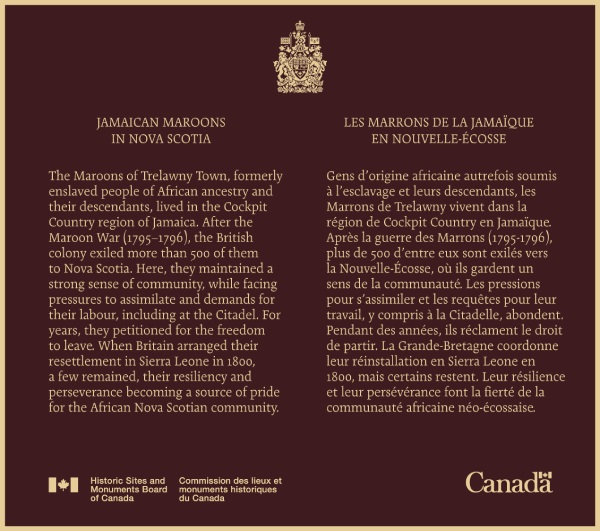The Jamaican Maroons in Nova Scotia National Historic Event

© Nova Scotia Archives / B. Edwards. The Proceedings of the Governor and Assembly of Jamaica, in Regard to the Maroon Negroes [...] to which is prefixed an Introductory Account [...] of the Maroons [...] . London, 1796, F210 /Ed9, negative number: N-6202
The Jamaican Maroons in Nova Scotia were designated as a national historic event in 2022.
Historical importance: community in exile in Nova Scotia from 1796 until 1800, influence still felt by African Nova Scotians.
Commemorative plaque: will be installed at Halifax Citadel National Historic Site, 5425 Sackville Street, Halifax, Nova ScotiaFootnote 1
Jamaican Maroons in Nova Scotia
The Maroons of Trelawny Town, formerly enslaved people of African ancestry and their descendants, lived in the Cockpit Country region of Jamaica. After the Maroon War (1795–1796), the British colony exiled more than 500 of them to Nova Scotia. Here, they maintained a strong sense of community, while facing pressures to assimilate and demands for their labour, including at the Citadel. For years, they petitioned for the freedom to leave. When Britain arranged their resettlement in Sierra Leone in 1800, a few remained, their resiliency and perseverance becoming a source of pride for the African Nova Scotian community.
The Jamaican Maroons in Nova Scotia
In 1796, more than 500 Maroons from Trelawny Town in the mountains of northwestern Jamaica were forcibly transported to the British colony of Nova Scotia. Their experiences exemplified the insecure rights and freedoms of African-descended British subjects in the late-18th-century Atlantic world. In Nova Scotia, the Maroons maintained a strong sense of community in exile through adaptation, accommodation, and resistance. They reaffirmed their allegiance to the British monarch and acceded in some cases to local demands for their labour and their attendance at Christian churches and schools, while strongly opposing pressures to abandon traditional Akan spiritual and cultural practices. Although most Maroons left Nova Scotia for Sierra Leone in 1800, some individuals stayed behind. Their continued presence is reflected in the surnames, accents, idioms, customs, oral histories, and traditions of African Nova Scotians, for whom Maroon dignity, strength, resiliency, perseverance, and resistance to oppression are a continued source of pride.

The Maroons of Trelawny Town were formerly enslaved peoples of African ancestry and their descendants who had lived in the Cockpit Country region of Jamaica until their exile following the second and final Maroon War (1795–1796). Almost everyone from the town—approximately 150 families or more than 500 adults and children—were forcibly transported to Nova Scotia in April 1796. Many people became sick and several died during the voyage. Soon after the convoy reached Nova Scotia in July, the Maroons worked on rebuilding and strengthening the Halifax fortifications. The Maroons moved a few months later to lands in Preston township purchased with funds from the Jamaican government. There, they faced considerable pressures to convert to Christianity, adopt settler agriculture, and undertake hard manual labour for low wages. The Maroons responded in different ways, which included withholding their labour in protest. Disagreement exacerbated existing divisions within the community and resulted in a small number leaving Preston for Boydville under the leadership of Maroon Captain John Palmer.
For years, the Maroons tirelessly petitioned for the freedom to leave Nova Scotia. In the end, the British arranged for their migration to Sierra Leone, where 1,196 Black Loyalists from Nova Scotia and New Brunswick had been resettled in 1792. Given the choice, the Maroons would have rather returned to the mountains of northwestern Jamaica. In the end, however, 177 women, 151 men, and 222 children were aboard the transport ship HMS Asia when it anchored off the coast of Freetown on 30 September 1800.
A small number of Jamaican Maroons remained in Nova Scotia after 1800. The pride, resistance, self-determination, and unique cultural identity of the Maroons gained new significance in the second half of the 20th century within the contexts of social movements for greater civil rights and recognition of the diverse histories, cultures, and achievements of African-descended peoples. Today, the historical presence of the Jamaican Maroons still holds a prominent place within the collective memory of African Nova Scotians.
This press backgrounder was prepared at the time of the plaque unveiling in 2024.
The National Program of Historical Commemoration relies on the participation of Canadians in the identification of places, events and persons of national historic significance. Any member of the public can nominate a topic for consideration by the Historic Sites and Monuments Board of Canada.
- Date modified :